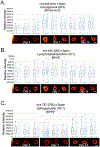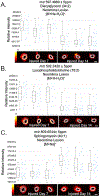Mass Spectrometric Imaging Reveals Temporal and Spatial Dynamics of Bioactive Lipids in Arteries Undergoing Restenosis
- PMID: 30784274
- PMCID: PMC6481175
- DOI: 10.1021/acs.jproteome.8b00941
Mass Spectrometric Imaging Reveals Temporal and Spatial Dynamics of Bioactive Lipids in Arteries Undergoing Restenosis
Abstract
Restenosis, or renarrowing of the arterial lumen, is a common recurrent disease following balloon angioplasty and stenting treatments for cardiovascular disease. A major technical barrier for deciphering restenotic mechanisms is the dynamic, spatial profiling of bioactive lipids in the arterial wall, especially in small animals. Here, applying matrix-assisted laser desorption/ionization mass spectrometric imaging (MALDI-MSI), we conducted the first lipidomic study of temporal-spatial profiling in a small animal model of angioplasty-induced restenosis. Cross sections were collected 3, 7, and 14 days after balloon angioplasty of rat carotid arteries. MALDI-MSI analyses showed that diacylglycerols (DAGs), signaling lipids associated with restenosis, and lysophosphatidylcholines (LysoPCs), whose function was uncharacterized in restenosis, dramatically increased at postangioplasty day 7 and day 14 in the neointimal layer of balloon-injured arteries compared to uninjured controls. In contrast, sphingomyelins (SMs) did not increase, but rather decreased at day 3, day 7, and day 14 in injured arteries versus the uninjured control arteries. These results revealed previously unexplored distinct temporal-spatial lipid dynamics in the restenotic arterial wall. Additionally, we employed time-of-flight secondary ion mass spectrometry (TOF-SIMS) tandem MS imaging for both molecular identification and imaging at high spatial resolution. These imaging modalities provide powerful tools for unraveling novel mechanisms of restenosis involving lipids or small signaling molecules.
Keywords: MALDI-MSI; TOF-SIMS; lipids; neointima; restenosis; vascular disease.
Conflict of interest statement
The authors declare no competing financial interest.
Figures






Similar articles
-
Improved spatial resolution of matrix-assisted laser desorption/ionization imaging of lipids in the brain by alkylated derivatives of 2,5-dihydroxybenzoic acid.Rapid Commun Mass Spectrom. 2014 Mar 15;28(5):403-12. doi: 10.1002/rcm.6796. Rapid Commun Mass Spectrom. 2014. PMID: 24497278 Free PMC article.
-
Nitrogen and Sulfur Co-doped Carbon-Dot-Assisted Laser Desorption/Ionization Time-of-Flight Mass Spectrometry Imaging for Profiling Bisphenol S Distribution in Mouse Tissues.Anal Chem. 2018 Sep 18;90(18):10872-10880. doi: 10.1021/acs.analchem.8b02362. Epub 2018 Sep 5. Anal Chem. 2018. PMID: 30139256
-
Intact lipid imaging of mouse brain samples: MALDI, nanoparticle-laser desorption ionization, and 40 keV argon cluster secondary ion mass spectrometry.Anal Bioanal Chem. 2016 Sep;408(24):6857-68. doi: 10.1007/s00216-016-9812-5. Epub 2016 Aug 22. Anal Bioanal Chem. 2016. PMID: 27549796 Free PMC article.
-
Surface analysis of lipids by mass spectrometry: more than just imaging.Prog Lipid Res. 2013 Oct;52(4):329-53. doi: 10.1016/j.plipres.2013.04.005. Epub 2013 Apr 24. Prog Lipid Res. 2013. PMID: 23623802 Review.
-
Cell and Tissue Imaging by TOF-SIMS and MALDI-TOF: An Overview for Biological and Pharmaceutical Analysis.Microsc Microanal. 2022 Feb;28(1):1-26. doi: 10.1017/S1431927621013593. Microsc Microanal. 2022. PMID: 34809729 Review.
Cited by
-
Angioplasty induces epigenomic remodeling in injured arteries.Life Sci Alliance. 2022 Feb 15;5(5):e202101114. doi: 10.26508/lsa.202101114. Print 2022 May. Life Sci Alliance. 2022. PMID: 35169042 Free PMC article.
-
Nullifying epigenetic writer DOT1L attenuates neointimal hyperplasia.Atherosclerosis. 2020 Sep;308:22-31. doi: 10.1016/j.atherosclerosis.2020.06.002. Epub 2020 Jul 2. Atherosclerosis. 2020. PMID: 32799103 Free PMC article.
-
Molecular Pathological Diagnosis of Thyroid Tumors Using Spatially Resolved Metabolomics.Molecules. 2022 Feb 18;27(4):1390. doi: 10.3390/molecules27041390. Molecules. 2022. PMID: 35209182 Free PMC article.
-
GDF11 alleviates neointimal hyperplasia in a rat model of artery injury by regulating endothelial NLRP3 inflammasome activation and rapid re-endothelialization.J Transl Med. 2022 Jan 15;20(1):28. doi: 10.1186/s12967-022-03229-6. J Transl Med. 2022. PMID: 35033112 Free PMC article.
-
Imaging of lysophosphatidylcholine in an induced pluripotent stem cell-derived endothelial cell network.Regen Ther. 2020 May 18;14:299-305. doi: 10.1016/j.reth.2020.03.007. eCollection 2020 Jun. Regen Ther. 2020. PMID: 32462058 Free PMC article.
References
-
- Heron M; Anderson RN Changes in the Leading Cause of Death: Recent Patterns in Heart Disease and Cancer Mortality. NCHS Data Brief 2016, No. 254, 1–8. - PubMed
-
- Cassese S; Byrne RA; Tada T; Pinieck S; Joner M; Ibrahim T; King LA; Fusaro M; Laugwitz KL; Kastrati A Incidence and predictors of restenosis after coronary stenting in 10 004 patients with surveillance angiography. Heart 2014, 100 (2), 153–9. - PubMed
-
- Wei GL; Krasinski K; Kearney M; Isner JM; Walsh K; Andres V Temporally and spatially coordinated expression of cell cycle regulatory factors after angioplasty. Circ. Res 1997, 80 (3), 418–26. - PubMed
Publication types
MeSH terms
Substances
Grants and funding
LinkOut - more resources
Full Text Sources

